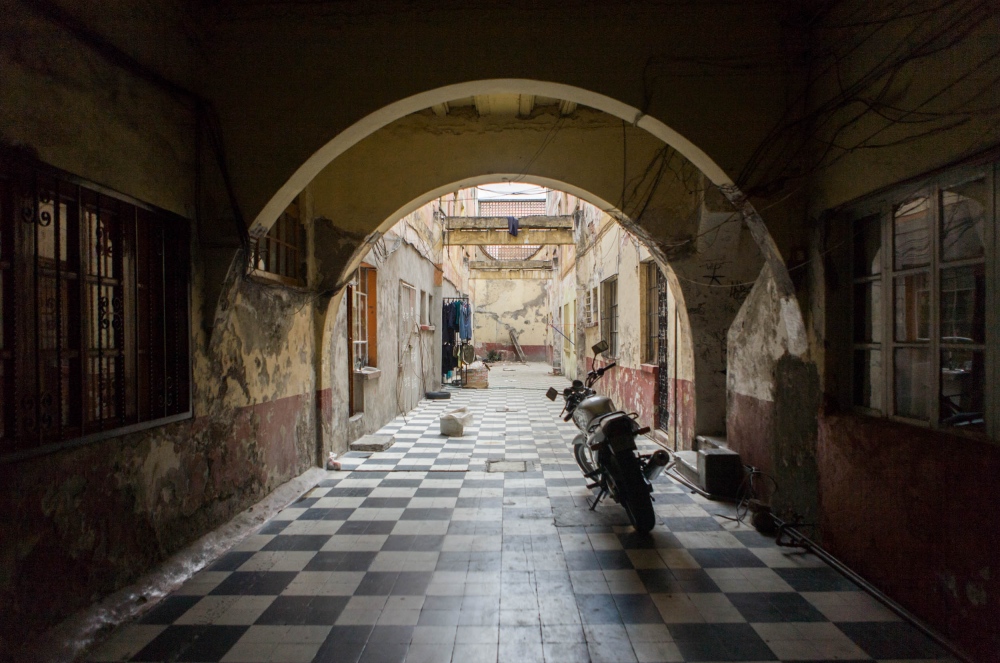Starting in 2008 and for a period of one year and a half I documented the struggle of the neighbours of Edificio América as they waited for the government to start construction on a building they sought expropriation back in 2005. According to expropriation laws in Mexico City, once the building becomes property of the government, the Public Housing Institute (INVI) -the administrative organ responsible for the construction or remodeling of these properties- has up to 5 years to complete the project and if it does not, the supposed "owner" has the right to fight back to recover the property.
Edificio América, is located in the central region of México City, in the neighborhood known as Roma. The 22 families living there have witnessed the transformation of their surroundings, from change of demographics to physical calamities that affected the entire community. Devastaded by the 1985 earthquake and then, starting in the 90s, deeply affected by a new wave of gentrification.
With many structural problems and with no administration office to recur to, the 22 families decided to organized themselves and expropriate the property. At the moment of the expropriation in 2005 they realized that there was no direct owner, but an up-and-coming housing delovoper firm known as LRDF- Los Reyes de la Finca, somehow purchased the property in a scam which was unravelled through the months of 2009 when a lawyer expert on expropriations was able to defend the tenants from being evacuated without an agreement to return to the reconstructed housing property. From 2005 - 2010 a cloud of uncertainty permeated the community, as they faced forced evacuation at any moment and the uncertainty that the agreement would be re-signed before the 5-year period, maintaining the agreement that the property was designated for social housing.
One month before the expropriation expired an agreement was signed between the 22 families and INVI in which the building was to be demolished and two towers were to be erected, maitaining the original facade which included 6 apartments that were to be remodeled. This process took five years, including one that was devoted only for demolition, which was performed by hand and by only two workers most of the time.Mérida90 is a project that presents itself as a testimony of a case of success against gentrification and displacement. The residents of the America building returned to the newly developed social housing units in July 2015, five years after they had to evacuated the building, not sure if there were to come back.
++ The project was published as a book by Tumbona Ediciones in 2011. To purchase click HERE
A short multimedia documentary : Mérida90: Mini-Doc ( with english subtitles).
* PRESS + PUBLICATIONS: [ soon ]
* México City. 2008 - 2012Mérida90 es un proyecto de investigación, fotografía y memoria histórica de los habitantes del edificio America, que a través de su organización, lograron expropiar el inmueble en donde viven, por medio del Instituto de Vivienda del Distrito Federal (INVI), para después conformar en ella viviendas de interés social.
El Edificio América se vio afectado por innumerables problemas de estructura y mantenimiento, sin una administración ni dueños conocidos por los habitantes. Varios de los inquilinos vivieron por más de medio siglo en el edificio y otros más llegaron durante los años ochenta, después de que la colonia se vio gravemente afectada por el sismo de 1985 y en la que se suscitó una migración masiva del barrio. Debido a la negligencia de los administradores y a la dificultad para encontrar quien ayudara a reparar los daños estructurales, los habitantes del edificio se organizaron y lograron expropiar el inmueble a través del Instituto de Vivienda del Distrito Federal (INVI) con la finalidad de que en el mismo se pudieran conformar viviendas de interés social.
La expropiación del edificio fue aprovechada por el INVI con la intención de que, al cabo de cinco años, las instancias gubernamentales pudieran venderlo a algún grupo inmobiliario privado. Los inquilinos acudieron a un abogado particular y a través de un extenuante litigio que duró más de un año "mismo tiempo en el que estuve documentando la realidad de angustia e incertidumbre entre los habitantes" se firmó un acuerdo en el que lograron comprometer al Instituto para que pudieran regresar al mismo lugar donde tenían sus propiedades, sin la necesidad de ser desplazados a unidades habitacionales en las periferias del Distrito Federal.
El caso del Edificio América es considerado exitoso entre los miles de casos de tentativa de expropiación para la construcción de vivienda de interés social en terrenos localizados dentro de la zona central de la Ciudad de Mexico.
La fachada, catalogada por el Instituto Nacional de Bellas Artes (INBA) como Patrimonio Histórico, fue remodelada junto con seis departamentos que conformaban el primer bloque del edificio. Las torres internas y su patio central "que reflejaba la arquitectura de la época del Porfiriato" se demolió para dar cabida a dos nuevas torres que albergan 24 viviendas de 50 metros cuadrados cada una.
Los habitantes han vuelto a ocupar el Edificio América desde junio de 2015, cinco años después de que el predio fue evacuado para dar inicio a la demolición y la posterior reconstrucción de los departamentos.
+ La documentación de habitantes mientras todavía ocupaban el Edificio America, así como el seguimiento del caso jurídico comandado por del abogado Julio O. Zenon, y, finalmente, el processo de demolición del edificio América, que duró 1 año, ha sido compilado en el libro Mérida90, editado y publicado por Tumbona Ediciones y Conaculta en 2011.
+ Se creó un breve video documental - Mérida90: Mini-Doc - con fotografías y secuencias de stop-motion, acompañada de testimonios orales de algunos habitantes explicando la problemática, incluyendo tambien el processo de demolicón del edificio, el cual no llegó a ser incluido en el libro.
+ Este proyecto fue expuesto en la exposición " Gentrificación no es un nombre de Señora" en el Museo de Arte Moderno en la Ciudad de Mexico en 2014 y en la exposicion Piso Pioto: Mexico - Barcelona en el Museo Franz Mayer. Se publicó en varias revistas nacionales e internacionales.
* PRENSA + PUBLICACIONES : [ en breve ]
* México. 2008 - 2012





































